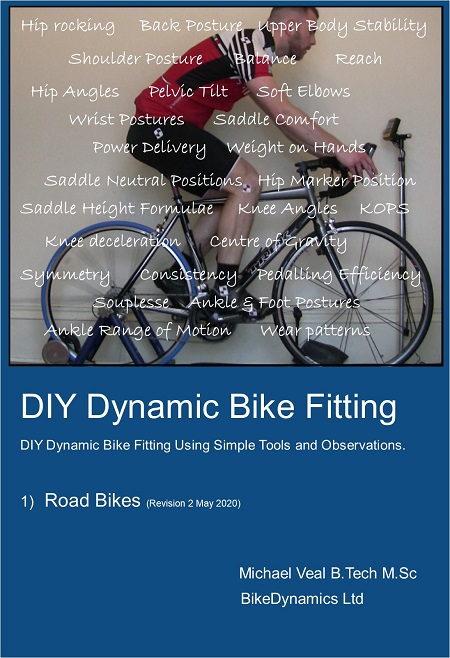Handlebar Reach
Handlebar reach in simple terms is the distance between saddle and handlebars. It could be better desribed as the horizontal and vertical distances between the two. It is actually quite complex, with the different facets of torso angle; shoulder, elbow and wrist postures; and the grip of the hands on hoods or drops all important to a good Bike Fit.
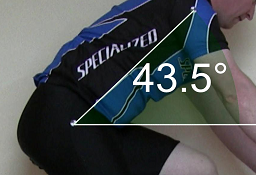
Torso Angles - On the Hoods
Torso angle is very dependent upon the cyclists choice of performance and comfort. Tyically on the hoods, the torso will be between 40° and 50°. A lower position is more aerodynamic as frontal surface area is reduced, but does rely on reasonably good flexibility. A more relaxed torso angle will take the pressure off the lower back, hamstrings and neck and is a suitable angle for longer distances where comfort is the priority over speed.
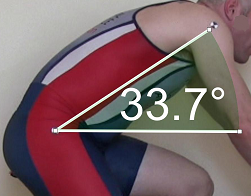
Torso Angles - On the Drops
The difference in torso angles between the hoods and drops will depend a little on handlebar choice, but typically around 10°. This gives a range of 30° to 40°.
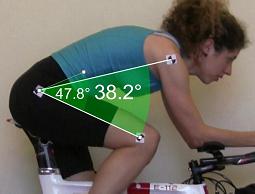
Minimum Hip Angles
Torso angles significantly less than 30° can only be achieved using specific Time Trial or Triathlon bikes. Although being lower at the front will reduce aerodynamic drag, the minimum hip angle can tighten to a point where both comfort and power are compromised. Note how there is a difference between the 'actual' hip angle measured between the body reference points and the 'real' hip angle due to the curvature of the spine. The ideal 'real' hip angle will vary between individuals and is dependent upon their flexibility and duration of events.
The 'actual' hip angle is easier to measure and men of average flexibility should be able to sustain 45° to 50° for some time, whereas very flexible women as shown here can hold angles of less than 40°.
The minimum hip angle can be affected by saddle height and fore-aft position, crank length and the position of the bar extensions and elbow pads. Moving forwards onto the tip of the saddle will open up the hip.
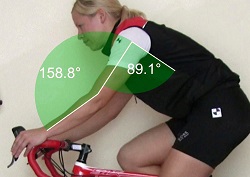
Arm, Shoulder and Elbow Posture
On a road bike, the upper arm should be between 85° and 90° to the upper body. More importantly, the shoulders should be relaxed with no tendency to hunch or roll forwards. Similarly the elbows should be soft with a gentle bend. Hunched shoulders or straight arms are indicative of there being too much weight on your hands or the bars being too far away.
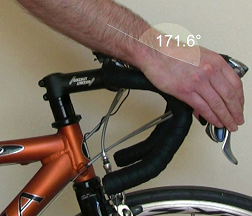
Hand Position
Dropped handlebars are designed to offer a number of holds to facilitate both alternative torso angles and a variety of hand positions. This is to suit different road conditions and prevent discomfort due to staying in one position for too long. Once saddle height and set back has been established, stem length and height should be set such that the hands fall naturally to the hoods. This offers the alternatives of a more relaxed position up on the bars and a more aerodynamic position on the drops. If riders spend nearly all their time up on the bar tops, either their top tube or their stem is too long for them, (or their saddle position is very wrong). The hoods should be adjusted to give a neutral wrist posture (as when shaking hands), whilst ensuring good lever access on the drops.
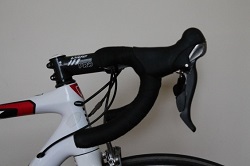
Shifter Position on the bars
The shifters should be set to give a smooth flat transition from the bars onto the hoods. This is to spread loads evenly across the palms. A horizontal 'platform' is a good start point but the bars can either be rolled up or down a couple of degrees as appropriate. Rolling the bars up will bring the hoods closer and higher, but compromise access to the brake levers on the drops. Rolling forwards will give a better drops position, but compromise the reach to the hoods.
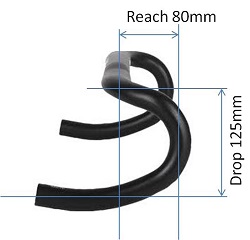
Adjustment - Length and Drop
The total 'Reach' to the hoods is made up of the vertical and horizontal distances from the saddle. The horizontal distance is made up of the frame top-tube length, the stem length, the local reach of the handlebars and the type and position of the shifters on the bars. The vertical distance is dependant upon the frame 'stack', spacers, stem length and inclination, shifter type, position and bar angle. The 'drop' of the bars defines the height difference between hoods and drops. Within limits, all these are adjustable to give the desired riding position.
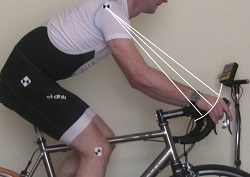
Adjustment - Alternative Strategies
As we have some tolerance on acceptable shoulder, arm , elbow postures etc. There could be a number of different but equally valid stem / bar combinations. In simple terms, the horizontal distance to the hoods could be longer, provided they are also higher. Similarly a short reach could be lower. This can provide an escape route if the frame is the wrong size. For example if the top tube is too long, a short, high stem could give an acceptable configuration.
DIY Dynamic Bike Fitting
You may be interested in our downloadable DIY guide.
49 Page PDF download describing all the observations, simple measurements and calculations required to do your own Dynamic Bike Fits.
Revision 2 released May 2020.
Contains updated male and female saddle height calculators and new information on male / female leg length proportions. Plus a new section to assist with saddle choice and improving comfort.
British Pound, Euro and US Dollar payments are processed by PayPal and all major credit cards are accepted. You will receive an email confirming your payment and will be automatically redirected to a page where you can download the ebook. The ebook is in PDF format so you will need to have a copy of Adobe Acrobat Reader or a similar PDF reader to read the ebook.

